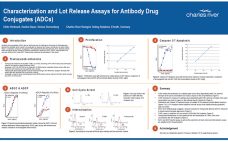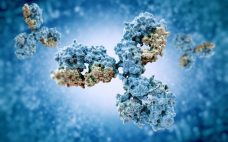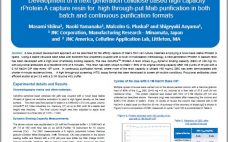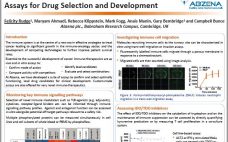Antibody-drug conjugates (ADCs) add an additional level of challenge to testing of biotherapeutics. Besides the antibody, which needs to be evaluated for potential and known mechanisms of action (MoA), there is a cytostatic compound conjugated that alters the behavior of the antibody-vehicle within the typical assays. Therefore, characterization of new innovators as well as biosimilarity assessment is even more challenging than it is for antibody therapeutics. Using the example of Trastuzumab emtansine, Charles River has set up a panel of…
Posters
Keeping Host Cell Protein ELISAs Covered
Biological drugs (or biologics) are manufactured by living systems such as microorganisms, and plant and animal cells. Cell lines, like Chinese hamster ovary (CHO), can be engineered to work as cellular factories to produce biologics in addition to their own biological molecules. Host cell proteins (HCPs) are biological by-products of these cellular factories. They are one of the main impurities in harvested cell culture fluid (HCCF), and tend to be released when the cells die or are damaged. These HCPs…
Removal of Isoagglutinins from IVIG and Plasma Using Affinity Chromatography
Antibody-mediated haemolysis is a hard-to-predict phenomenon with potentially severe consequences. It is mediated by naturally-occurring anti-A and anti-B immunoglobulin isoagglutinins, which are present in plasma, blood, and several derived products, including IVIG produced by plasma fractionation. Prometic Bioseparations have developed an affinity chromatography resin for the removal of isoagglutinins from plasma and plasma derived products, such as IVIG. The resins, IsoClear A and IsoClear B, can clear isoagglutinins from a titre of 1/32 down to negative agglutination using a load…
Expansion, Recovery and Characterization of hMSCs on Dissolvable Microcarriers for Bioprocess Applications
Human mesenchymal stem cells (hMSCs) are currently the most common adult stem cell type used for cell therapy applications due to their regenerative properties and ability to differentiate into multiple cell lineages (adipocyte, chondro¬cyte, and osteocyte). Traditionally, hMSCs have been cultured on two-dimensional cell culture platforms using serum-containing medium. Although these platforms can be used successfully for small-scale expansion of hMSCs, other platforms will be required to generate the quantity of cells required to support the increasing number of clinical…
Development of a Next Generation Cellulose-Based High Capacity rProtein A Capture Resin for High Throughput MAb Purification in Both Batch and Continuous Purification Formats
A new product development approach will be described for the affinity capture of Mab’s from cell culture materials employing a novel base stable rProtein A ligand. Using a stable cellulose base bead with excellent flow properties coupled with a novel immobilization methodology, a next generation rProtein A capture resin has been developed with a high level of antibody binding capacity. The new Cellufine™ rProtein A resin shows C20% dynamic binding capacity (DBC) of >50 mg/ mL with polyclonal antibodies at…
Long-Term Reliability of an Aseptic On-line Glucose Monitoring and Control System for Perfusion CHO Cell Culture
Among the variables that are appropriate for direct feedback control of the perfusion rate in mammalian cell cultures, high priority should be given to the glucose concentration. Here we describe the application of a closed-loop control scheme for the long-term cultivation of CHO cells in a high cell density (35 – 40 million cells/ml) perfusion process. The monitoring and control system worked successfully for 2.5 months without any signs of performance degradation. In targeting industrial applications, issues such as reliability,…
Beta Cyclodextrin Derivatives as Protein Aggregation Modulators
Protein aggregation is the major challenge encountered during manufacturing, storage and transportation of biopharmaceuticals (1,2). The objective was to evaluate the effect of two ßcyclodextrins derivatives: (KLEPTOSE® HPB hydroxypropyl-ß-cyclodextrin, with MS=0.65) and (KLEPTOSE® HP hydroxypropyl-ß-cyclodextrin, with MS=0.9) on two biologic drugs (Infliximab and Etanercept) aggregation using high-throughput formulation screening (iFormulate™) and nanoDSF (Differential Scanning Fluorimetry) (3,4). Preliminary results demonstrate that KLEPTOSE® HPB BioPharma hydroxypropyl-ß-cyclodextrin and KLEPTOSE® HP BioPharma hydroxypropyl-ß-cyclodextrin at high molarity (200 mM) are efficient tools in modulating Infliximab…
Novel Single-Use Systems Allow Faster Powder Transfer and Higher Recovery Rates (Poster)
Single use powder containment practices are still in their infancy but keeping your product from cross contamination and reducing airborne particulates is important. Understanding how more modern bag designs can increase safety and speed is a concern to the industry. We looked at the ease of fill along with dispensing times and product loss. ILC Dover’s EZ-Biopac shows a 71% decrease in filling times when measured against an industry standard 2D bag. Due to the non-static film we saw an…
Immuno-Oncology Therapies: In Vitro Functional Assays for Drug Selection and Development
The immune system is at the center of a new era in effective strategies to treat cancer leading to significant growth in the immunooncology sector, and the development of competing technologies to further improve patient survival rates. Essential to the successful development of cancer immunotherapeutics are ex vivo and in vitro assays to: Confirm mode of action Compare activity with competitors Identify lead candidates Evaluate and select combinations At Abzena, we have developed a suite of assays to confirm and…
Comparison of the Finesse SmartGlass™ and SmartVessel™ 3L Bioreactors: Engineering Data and Cell Cultivation Results
Finesse Solutions Inc. recently introduced the single-use benchtop scale SmartVessel 3L bioreactor, which was developed based on its re-usable counterpart, the SmartGlass bioreactor. With identical main geometrical parameters, the plastic bioreactor mimics the glass vessel with minor modifications for manufacturability. The following study focuses on the engineering data of both vessels, which have been determined with special focus on animal cell culture applications. Furthermore, data from material tests on leachables and extractables as well as results from cell cultivations using…










